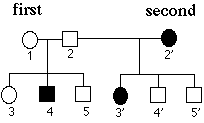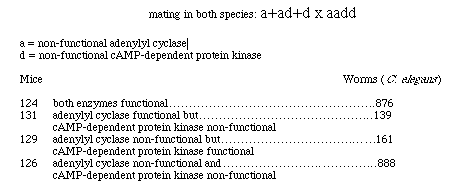
Fall 1998 Biology 111 Exam #2 - Genetics, through linkage
There is no time limit on this test, though I have tried to design one that you should be able to complete within 2.5 hours, except for typing. There are four pages on this test. You are not allowed to use your notes, old tests, any electronic sources, any books, nor are you allowed to discuss the test with anyone until all exams are turned in at 10:30 am on Monday October 19. EXAMS ARE DUE AT CLASS TIME ON MONDAY OCTOBER 19. You may use a calculator and/or ruler. The answers to the questions must be typed on separate sheets of paper unless the question specifically says to write the answer in the space provided. If you do not write your answers on the appropriate pages, I may not find them unless you have indicated where the answers are.
Please do not write or type your name on any page other than this cover page. Staple all your pages (INCLUDING THE TEST PAGES) together when finished with the exam.
Name (please print):
Write out the full pledge and sign:
How long did this exam take you to complete (excluding typing)?
Lab Questions:
3 pts.
1) What is the total magnification of the image you are seeing when the
light is set at 3.5, the condenser aperture is opened 88% of its full capacity,
the ocular says 12.5X, the objective lens says 60X, you are using dark field
illumination, and there are only 20 microliters of cells on the microscope
slide?
3 pts.
2) I want to test the affects of ethanol on cells regenerating their
flagella. What control, or controls, should I include in my experiment?
4 pts.
3) How can you tell a Chlamydomonas zygote from a Chlamydomonas
gamete? Give me two ways you can tell, but indicate which one is
the easier way.
Lecture Questions:
15 pts.

4) A man was married to a woman and together they had three children. Tragically, they were in a terrible car accident and everyone died except him. Years later, he remarried a second wife (2 ') and together they had three children.
a) What are the odds that he would have four boys and two girls in these two families?
b) What are the odds that he would have a girl and then two boys, followed
by the same
pattern of children again?
c) Is the disease a dominant, recessive or codominant one? Explain your
answer to
receive full credit.
d) What were the odds that child number 4 would inherit the disease?
e) What were the odds that child number 4 ' would inherit the disease?
6 pts.
5) Using the pedigree above, list the genotypes of all six children.
5 pts.
6) Draw a pedigree for a family that has two parents, three children,
two of whom have Huntington's disease.
4 pts.
7) If a rare trait, thumb nails on the wrong side of your thumb, is
on the same chromosome as blood type, explain how one child could wind up
with her mother's blood type but her father's thumbs while another winds
up with her mother's blood type and her mother's thumbs. In this situation,
you do not need to worry about genotypes, or blood type alleles, though
this is a test cross with the father being the homozygote. I want you to
discuss in general terms two processes that can happen during gametogenesis
that lead to this type of genetic variation.
9 pts.
8) You may have heard in the news that swarm of fruit flies was capture
that had an unusual collection of traits. Two were mated and this couple
produced 88 with pink eyes and 30 with pale yellow eyes.
a) Which allele is dominant?
b) Describe what your answer to a means in both Mendelian and molecular terms.
c) What were the genotypes of the parents in this mating?
10 pts.
9) a) Draw schematic picture of a piece of DNA and indicate the location
of the
following terms on your diagram: coding strand; promoter; enhancer; start
transcriptions site; start translation site.
b) Define the terms chromosome, chromatid, allele, locus, and gene. In
order to get
full credit, you must draw a picture to illustrate your complete understanding
of
these terms.
6 pts.
10) In the space provided, draw a picutre of one RNA nucleotide monophosphate.
Properly label all the carbons in the sugar, but don't worry about drawing
the base, just choose a base and write out the word in full to indicated
which base you chose.
9 pts.
11) List and explain three types of mutations that might affect protein
function besides those mutations that occur within the coding region.
4 pts.
12) What would your phenotype be if your karyotype were XY and your
SRY gene had a point mutation that produced a silent mutation.
8 pts.
13) A new drug is being tested on people with sickle cell and it is
called hydroxyurea. Is this a cure for the disease? Explain your answer.
Will those receiving hydroxyurea still be at risk of having children with
SC?
6 pts.
14) Describe the molecular defect in people with CF as determined by
the experiment done by Sato and Sato.
8 pts.
15) Indicated which genes are linked and which ones are unlinked. If
any are linked, determine the genetic distance between the appropriate loci
and which alleles were linked to each other in the mother:
Morgan nomenclature used here:
